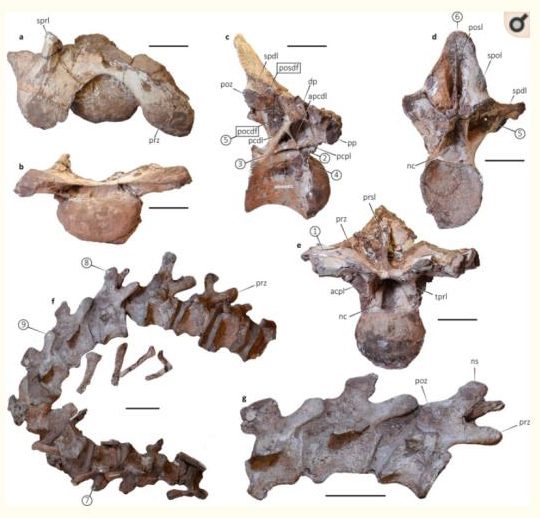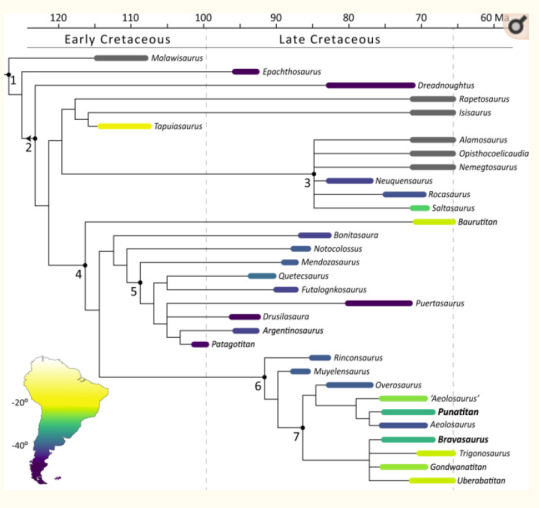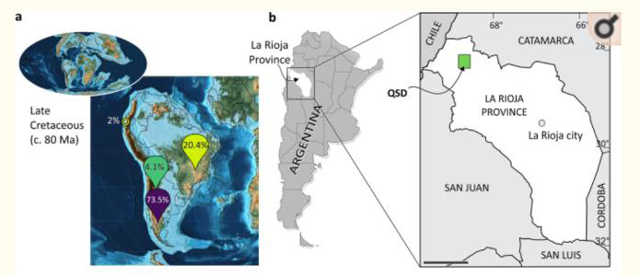Two New South American Titanosaurians
Two New South American Titanosaurians
The last type of sauropod to have lived were the Titanosauria, a clade consisting of a variety of taxa that were geographically widespread. Fossils of titanosaurs have been found on every continent. These long-necked herbivores seem to have been particularly successful in South America, with some of the largest tetrapods of all time – Argentinosaurus, Patagotitan and Dreadnoughtus known from this continent.
A team of scientists based in Argentina recently published a paper describing two new South American titanosaurs from the province of La Rioja located in the north-west of that country. The dinosaurs named Punatitan coughlini and Bravasaurus arrierosorum, help to fill a gap between the types of titanosaurs associated with Patagonia and south-western Brazil, the two main locations associated with Titanosauria fossil discoveries from South America.
Skeletal Drawings Punatitan coughlini (c) and (d) Bravasaurus arrierosorum

Picture credit: Hechenleitner et al (Communications Biology)
Dinosaurs from the Andes – Titanosaurs Demonstrate Philopatry
The fossil material representing three individuals was found in the Upper Cretaceous red beds of the Quebrada de Santo Domingo locality in the Andes of La Rioja province. In addition, a large number of titanosaurian egg clutches and eggshells were recovered. Such was the abundance of eggshell found that this location is regarded as one the largest dinosaur nesting sites known in the world. These fossils help to support the theory that these types of dinosaurs returned to the same, favoured nesting area year after year, the titanosaurs demonstrated philopatry (the tendency of an organism to habitually return to the same location, usually to breed or to nest).
Cervical and dorsal vertebrae of Punatitan coughlini

Picture credit: Hechenleitner et al (Communications Biology)
Limb Bones Associated with Bravasaurus arrierosorum

Picture credit: Hechenleitner et al (Communications Biology)
Titanosauria Phylogenetic Analysis
A phylogenetic analysis undertaken by the research team suggests that both Bravasaurus and the much larger Punatitan have affinities with both Patagonian and Brazilian titanosaurs. The discovery of these two genera, both classified within the sub-clade of the Rinconsauria, supports the hypothesis of a close relationship between titanosaurian faunas in South America during the Late Cretaceous.
Titanosaur Palaeogeographical Distribution and Phylogeny

Picture credit: Hechenleitner et al (Communications Biology)
The Site of the Fossil Discoveries and Plotting the Location of Titanosaurs in South America

Picture credit: Hechenleitner et al (Communications Biology)
The scientific paper: “Two Late Cretaceous sauropods reveal titanosaurian dispersal across South America” by E. Martín Hechenleitner, Léa Leuzinger, Agustín G. Martinelli, Sebastián Rocher, Lucas E. Fiorelli, Jeremías R. A. Taborda, and Leonardo Salgado published in Communications Biology.
Visit the Everything Dinosaur website: Everything Dinosaur.

